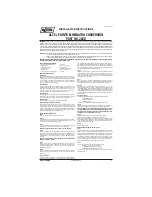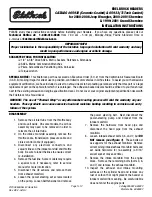
102
Points to remember
Electrical system
When replacing the battery or when carrying
out work involving the electrical system, the
following should be observed:
•
A battery connection to the wrong terminal
will damage the electrical system. Be sure to
connect the positive battery cable to the
positive battery terminal and the negative
battery cable to the negative battery
terminal.
•
If booster batteries are used for starting,
they must be properly connected to mini-
mize the risk of the electrical system being
damaged. For correct connection, see "Jump
starting" section.
•
Never disconnect the battery circuit (for
example, to replace the battery) while the
engine is running, as this may damage the
generator. Always make sure that all the
battery connections are properly cleaned
and tightened.
•
If any electrical welding work is performed
on the vehicle, the battery's ground lead
(negative cable) and all the connecting
cables of the generator must be disconnect-
ed and the welder cables placed as near the
welding points as possible.
•
The radio must be turned off before the
battery is disconnected.
•
Switch off the ignition for at least 10
minutes before disconnecting the battery.
CAUTION
:
Drive slowly and carefully if going through
standing water (i.e. flooded roadways, etc.).
Damage to the engine could result if excess
water is drawn in through the air intake
system. Never drive the vehicle in water
deeper than 1 foot (300 mm). See the flood
warning on page 5.
WARNING!
•
Driving with the tailgate open:
Driving
with the tailgate open could mean that
poisonous exhaust gases enter the
passenger compartment.
If the tailgate must be kept open for any
reason, proceed as follows:
- Close the windows.
- Set the ventilation system to air flow to
floor, windshield and side windows and
blower control to its highest setting.
•
Floor mats:
An extra mat on the driver's
floor can cause the accelerator pedal to
catch. Check that the movement of the
accelerator pedal is not impeded. Not
more than one protective floor covering
may be used at one time.
Cooling system
The risk for engine overheating is greatest,
especially in hot weather, when:
•
Towing a trailer up steep inclines for
prolonged periods at wide open throttle and
low engine rpm.
•
Stopping the engine suddenly after high
speed driving (so-called after-boiling can
occur).
•
To avoid overheating, the following rules
should be followed:
Do not drive for prolonged periods at engine
speeds above 4500 rpm if you are towing a
trailer in hilly terrain.
Reduce speed when towing a trailer up long,
steep inclines. The risk of overheating can be
reduced by switching off the air conditioning
system for a short time.
Do not let the engine idle unnecessarily for
prolonged periods.
Do not mount auxiliary lamps in front of the
grill.
When the risk of overheating is imminent, or in
the event of overheating (the temperature
gauge goes repeatedly into, or stays continually
in, the red section), the following precautions
should be taken:
•
Switch off the air conditioning system.
•
Pull off the road, away from traffic, stop the
car and put the gear selector into neutral.
•
Switch the heater to full (maximum)
position. Increase the engine speed to
approx. 2000 rpm (twice idling speed) until
the temperature begins to drop.
WARNING!
Do not remove coolant expansion tank cap.
The coolant will be extremely hot.
If necessary, see page 154 for information on
checking and topping-up the coolant level.
Summary of Contents for 2006 XC70
Page 1: ...2006 ...
Page 4: ......
Page 8: ......
Page 54: ...46 ...
Page 86: ...78 ...
Page 142: ...134 ...
Page 182: ...174 ...
Page 208: ...200 ...
Page 209: ...201 ...
Page 210: ...202 ...
















































